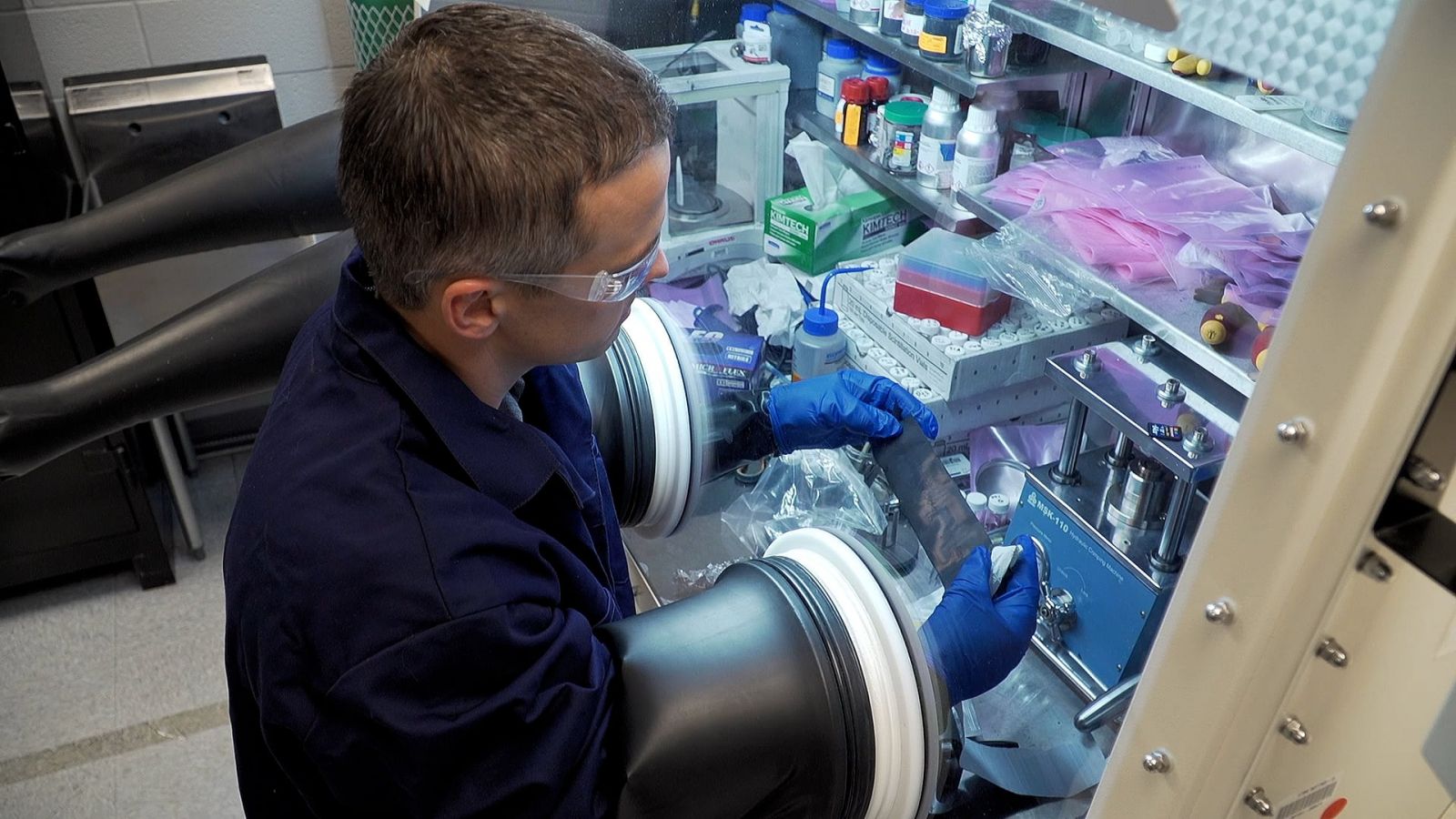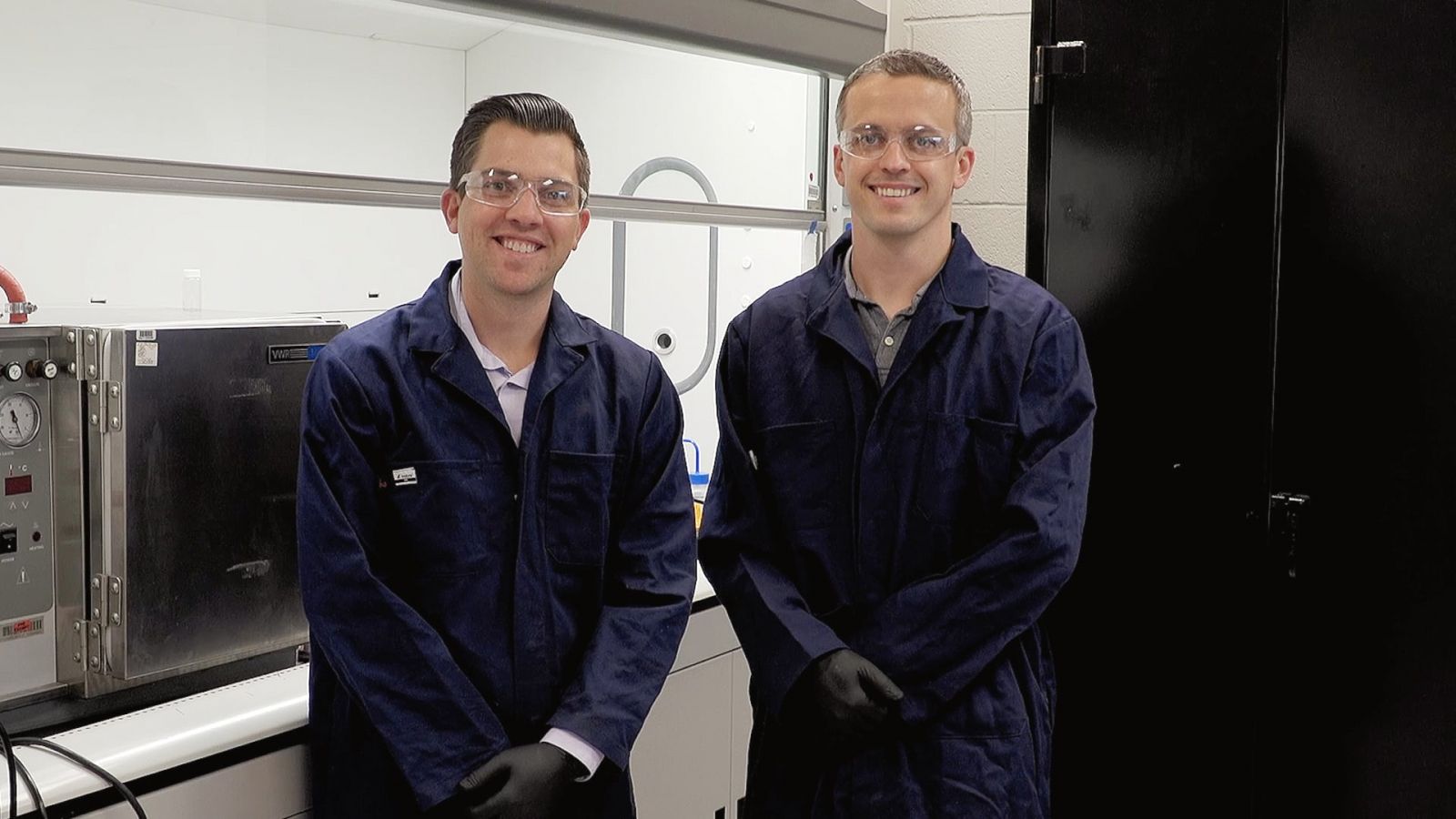Source: Sarah K. Miller, NSWC Crane Corporate Communications

CRANE, Ind. – Naval Surface Warfare Center, Crane Division (NSWC Crane) continues its collaboration with Purdue University researchers to establish laboratory testing capability, enhance performance, and improve safety of lithium-ion batteries. Since a Cooperative Research and Development Agreement (CRADA) with Purdue was signed in 2018, the Navy and academic teams have launched a lab for testing, conducted unique research, developed modeling and simulation (M&S) techniques, and published nine academic papers on their efforts.
Kyle Crompton, a chief engineer at NSWC Crane, has led this effort since 2017 to build a lithium-ion experimental cell fabrication and testing lab at Crane and collaborate with Purdue for research. Crompton was a Department of Defense (DoD) Science, Mathematics, and Research for Transformation (SMART) Scholar who leveraged internal NSWC Crane Naval Innovative Science and Engineering (NISE) funding for several years to form this capability.
“It has been exciting setting up the lab and establishing the relationship with Purdue,” said Crompton. “We’ve had to take some risks, focus on the long-term vision, and pursue the science. The ultimate goal is to produce new knowledge and new information—where people can grab it and grow from it whether they are in the military, academia, or industry. Not only have we published research, but we have data sets that can be leveraged in a public repository.”
Lithium-ion batteries power everyday technologies, from personal electronic devices like cell phones and electric toothbrushes—to larger technologies such as electric vehicles (EVs), large power grid sources, and backup batteries for buildings and facilities. Lithium-ion batteries are popular mobile energy resources due to being lightweight, high energy density, and rechargeable.
NSWC Crane has more than 60 years of history of supporting energy storage systems. For instance, the Airborne and Space Energy Systems Branch, where Crompton was previously the manager, has capabilities such as system engineering and test and evaluation for aircraft, satellite, and spacecraft energy storage. This includes battery engineering for military systems like fighter jets and missiles.
The U.S. Navy requires rigorous testing of these batteries before their use on DoD systems to ensure full functionality and safety. This rigorous testing process for high-powered lithium-ion batteries can be costly and hazardous.
“Lithium-ion batteries have higher energy density, can store more energy per mass of the battery with up to five times storage capability than legacy batteries—it’s lighter and smaller which is a big advantage,” said Crompton. “However, with more energy comes a safety challenge.”
Crompton said thermal runaway is the main safety concern of lithium-ion batteries.
“It can happen when lithium-ion batteries are abused, and cause a rapid fire or explosion,” said Crompton. “Mitigation of this safety concern is currently based on extensive testing and containment engineering. Our idea has been to develop and validate a model that can take the place of some testing and therefore, save time and cost. Through the CRADA with Purdue, we’ve made substantial progress building a detailed 3D model that can simulate thermal runaway of lithium-ion batteries. This is has been a lofty goal, with a lot more research and development still needed. In about four years’ time, though, we have made a lot of progress.”
He said Purdue and NSWC Crane have complementary capabilities for this experimentation and simulation-based research.
“The collaboration has been mutually beneficial. Purdue has modeling and theory expertise and NSWC Crane has unique laboratory testing capability,” said Crompton.

Jason Ostanek, assistant professor of engineering technology at Purdue University and temporary faculty member at NSWC Crane, leads the collaborative research from Purdue’s perspective. He works in the Applied Thermo-Fluids Laboratory with students on a wide variety of projects. Prior to his work at Purdue, Ostanek was an employee at NSWC Philadelphia Division for several years. He said individual battery cells, when operated within their specified parameters, are not likely to catch fire.
“The reputation of the lithium ion battery is that they catch fire,” said Ostanek. “In reality, the failure rate of individual cells is one in tens of millions. Batteries for Navy platforms, like ships, are much larger, consist of thousands of individual cells connected to one another. In these larger systems, the chances of failure increase, first because there are more points of failure, but second because it is more difficult to maintain every individual battery cell within its specified operating parameters. It is standard process that these large battery systems have to go through a certification process before they are fielded. Only after a battery passes this process can it be used in the fleet; that process is extremely costly, and is time consuming. For instance, if you were to certify a cell phone battery—testing would be quick, easy, and if the battery was destroyed in testing it’s not a big deal. That’s where this project comes into play.”
Ostanek said the Purdue team is modeling the physics of battery failures.
“There’s a lot of research and data available on single cell batteries that we can check our modeling against—but there’s far less data available when you have multiple battery cells similar to what the Navy uses,” said Ostanek. “There are many variables and it is much more complicated. The computer simulation needs a lot of inputs: battery geometry, dimensions, arrangement of different materials, and amount of heat the battery creates in a failure.”
Ostanek said there are several challenges to this effort that provides valuable research output.
“Battery failures come with messy thermophysical processes that result in a lot of variability in the outcome of a failure—you could experiment ten times and get a spectrum of answers,” said Ostanek. “It takes time to develop theory, models, interpret results, program and make it run quickly. We’re modeling gas generation, venting, and combustion of those gases, which nobody has done before with battery modules. With these advances, we’re closer to capturing the variability observed in experimental testing. If we continue to build capability, capture the key physical process, then our models will have greater predictive capability and may someday help supplement the certification process.”
Crompton said these research efforts feed into the knowledge base for lithium-ion battery performance and safety.
“Our basic and applied research can help get future batteries safely and reliably to DoD platforms safely,” said Crompton. “It feeds into providing general capability, reliability, and improved workforce knowledge level. Going forward we want to continue developing the general modeling capability, but are also start to pull value from the models developed so far by using them to solve problems from narrower, more specific aspects of lithium-ion battery safety.”
About NSWC Crane
NSWC Crane is a naval laboratory and a field activity of Naval Sea Systems Command (NAVSEA) with mission areas in Expeditionary Warfare, Strategic Missions and Electronic Warfare. The warfare center is responsible for multi-domain, multi- spectral, full life cycle support of technologies and systems enhancing capability to today's Warfighter.
NAVSEA employs a diverse, highly trained, educated, and skilled workforce — from students and entry level employees to experienced professionals and individuals with disabilities. We support today's sophisticated Navy and Marine Corps ships, aircraft, weapon systems and computer systems. We are continuously looking for engineers, scientists, IT and cyber specialists, as well as trade and other support professionals to ensure the U.S. Navy can protect and defend America. Please contact NSWC Crane Human Resources at crane_recruiting@navy.mil.
